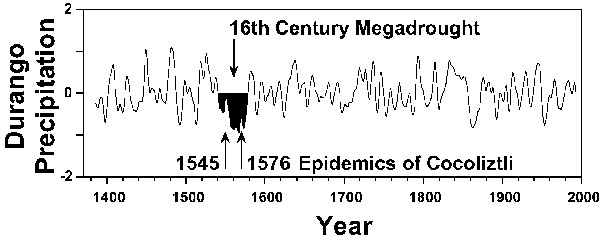Volume 8, Number 4—April 2002
Historical Review
Megadrought and Megadeath in 16th Century Mexico
Figure 2

Figure 2. Winter-spring precipitation reconstructed from tree ring data, Durango, Mexico (normalized and smoothed to highlight decennial variability). The tree-ring estimates explain 56% of the variance in precipitation for Durango and are consistent with independent precipitation data. This reconstruction is well correlated with the all-Mexico rainfall index (r = 0.76; p < 0.001) and with precipitation over north central Mexico, where the cocoliztli epidemics appear to have been most severe. Note the unprecedented 16th-century megadrought during both cocoliztli epidemics.
Page created: July 15, 2010
Page updated: July 15, 2010
Page reviewed: July 15, 2010
The conclusions, findings, and opinions expressed by authors contributing to this journal do not necessarily reflect the official position of the U.S. Department of Health and Human Services, the Public Health Service, the Centers for Disease Control and Prevention, or the authors' affiliated institutions. Use of trade names is for identification only and does not imply endorsement by any of the groups named above.